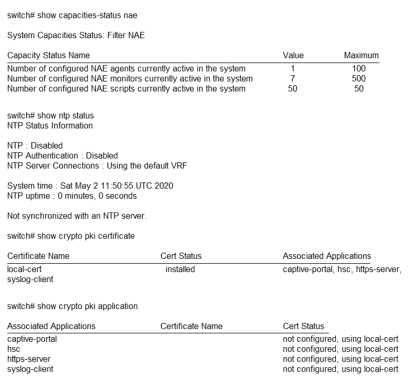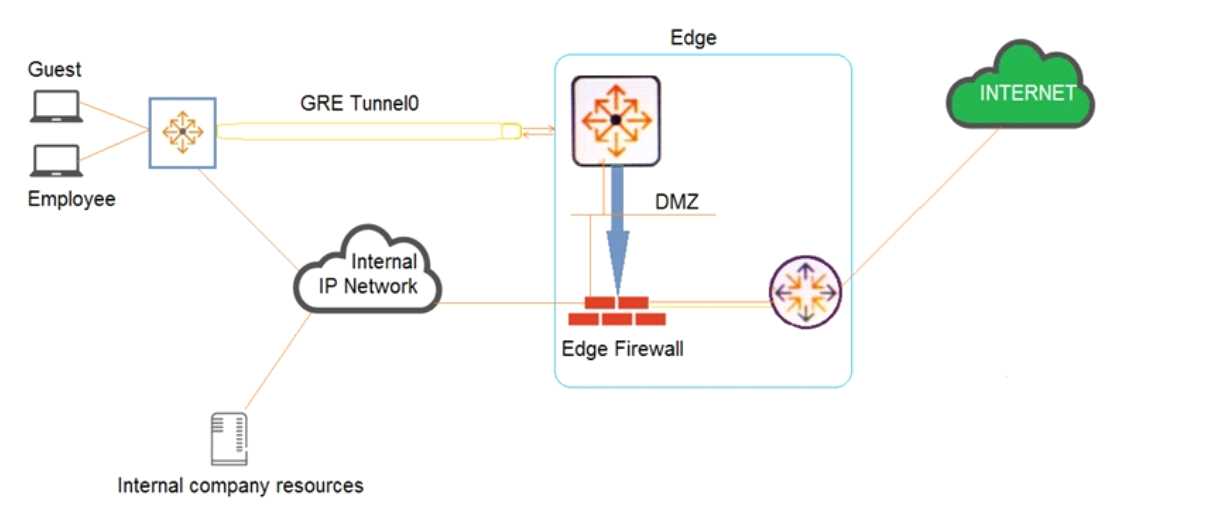HP HPE6-A73 Exam Questions
Questions for the HPE6-A73 were updated on : Jul 20 ,2024
Page 1 out of 7. Viewing questions 1-15 out of 100
Question 1
Which statement is correct regarding ACLs and TCAM usage?
- A. Applying an ACL to a group of ports consumes the same resources as specific ACE entries
- B. Using object groups consumes the same resources as specific ACE entries
- C. Compression is automatically enabled for ASIC TCAMs on AOS-CX switches
- D. Applying an ACL to a group of VLANs consumes the same resources as specific ACE entries
Answer:
B
Question 2
What is correct regarding rate limiting and egress queue shaping on AOS-CX switches?
- A. Only a traffic rate and burst size can be defined for a queue
- B. Limits can be defined only for broadcast and multicast traffic
- C. Rate limiting and egress queue shaping can be used to restrict inbound traffic
- D. Rate limiting and egress queue shaping can be applied globally
Answer:
A
Question 3
A network administrator needs to replace an antiquated access layer solution with a modular
solution involving AOS-CX switches. The administrator wants to leverage virtual switching
technologies. The solution needs to support high-availability with dual-control planes.
Which solution should the administrator implement?
- A. AOS-CX 8325
- B. AOS-CX 6300
- C. AOS-CX 6400
- D. AOS-CX 8400
Answer:
C
Reference:
https://andovercg.com/datasheets/aruba-cx-8325-switch-series.pdf
Question 4
A company has implemented 802.1X authentication on AOS-CX access switches, where two
ClearPass
servers are used to implement AA
A. Each switch has the two servers defined. A network engineer notices the following command
configured on the AOS-CX switches:
radius-server tracking user-name monitor password plaintext aruba123
What is the purpose of this configuration?
A. Implement replay protection for AAA messages
B. Define the account to implement downloadable user roles
C. Speed up the AAA authentication process
D. Define the account to implement change of authorization
Answer:
D
//techhub.hpe.com/eginfolib/networking/docs/switches/K-KA-KB/16-01/5200
-
0122_access_security_guide/content/ch09s02.html
Question 5
A company has an existing wireless solution involving Aruba APs and Mobility controllers running 8.4
code.
The solution leverages a third-party AAA solution. The company is replacing existing access switches
with AOS-CX 6300 and 6400 switches. The company wants to leverage the same security and firewall
policies for both wired and wireless traffic.
Which solution should the company implement?
- A. RADIUS dynamic authorization
- B. Downloadable user roles
- C. IPSec
- D. User-based tunneling
Answer:
D
Question 6
A network engineer is having a problem adding a custom-written script to an AOS-CX switchs NAE
GUI. The script was written in Python and was successfully added on other AOS-CX switches. The
engineer examines the following items from the CLI of the switch:
What should the engineer perform to fix this issue?
- A. Install the script’s signature before installing the new script
- B. Ensure the engineer’s desktop and the AOS-CX switch are synchronized to the same NTP server
- C. Enable trust settings for the AOS-CX switch’s SSL certificate
- D. Remove a script that is no longer used before installing the new script
Answer:
D
Question 7
Which option correctly defines how to identify a VLAN as a voice VLAN on an AOS-CX switch?
- A. Switch(config)# port-access lldp-group <LLDP-group-name> Switch(config-lldp-group)# vlan <VLAN-ID>
- B. Switch(config)# port-access role <role-name> Switch(config-pa-role)# vlan access <VLAN-ID>
- C. Switch(config)# vlan <VLAN-ID> Switch(config-vlan-<VLAN-ID>)# voice
- D. Switch(config)# vlan <VLAN-ID> voice
Answer:
C
Question 8
An administrator will be replacing a campus switching infrastructure with AOS-CX switches that
support VSX capabilities. The campus involves a core, as well as multiple access layers. Which feature
should the
administrator implement to allow both VSX-capable core switches to process traffic sent to the
default gateway in the campus VLANs?
- A. VRF
- B. VRRP
- C. IP helper
- D. Active gateway
Answer:
D
Question 9
What is correct regarding the tunneling of user traffic between AOS-CX switches and Aruba Mobility
Controllers (MCs)?
- A. Uses IPSec to protect the management and data traffic
- B. Uses IPSec to protect the management traffic
- C. Supports only port-based tunneling
- D. Uses the same management protocol as Aruba APs
Answer:
D
Question 10
An administrator is implementing a multicast solution in a multi-VLAN network. Which statement is
true about the configuration of the switches in the network?
- A. IGMP snooping must be enabled on all interfaces on a switch to intelligently forward traffic
- B. IGMP requires join and leave messages to graft and prune multicast streams between switches
- C. IGMP must be enabled on all routed interfaces where multicast traffic will traverse
- D. IGMP must be enabled on all interfaces where multicast sources and receivers are connected
Answer:
B
Question 11
How is voice traffic prioritized correctly on AOS-CX switches?
- A. By defining device profiles with QOS settings
- B. By placing it in the strict priority queue
- C. By implementing voice VLANs
- D. By implementing weighted fair queueing (WFQ)
Answer:
B
Question 12
An administrator is replacing the current access switches with AOS-CX switches. The access layer
switches
must authenticate user and networking devices connecting to them. Some devices support no form
of
authentication, and some support 802.1X. Some ports have a VoIP phone and a PC connected to the
same
port, where the PC is connected to the data port of the phone and the phones LAN port is connected
to the switch.
Which statement is correct about this situation?
- A. 802.1X must be configured to work in fallback mode
- B. Device fingerprinting is required for authentication
- C. The client-limit setting for port access needs to be changed
- D. Device mode should be implemented
Answer:
C
Question 13
Examine the network exhibit.
A company has a guest implementation for wireless and wired access. Wireless access is
implemented
through a third-party vendor. The company is concerned about wired guest traffic traversing the
same network
as the employee traffic. The network administrator has established a GRE tunnel between AOS-CX
switches
where guests are connected to a routing switch in the DMZ.
Which feature should the administrator implement to ensure that the guest traffic is tunneled to the
DMZ while
the employee traffic is forwarded using OSPF?
- A. OSPF route maps using the “set metric” command
- B. Policy-based routing (PBR)
- C. User-based tunneling (UBT)
- D. Classifier policies
Answer:
B
Question 14
An administrator has an AOS-CX switch configured with:
router ospf 1
area 0
area 1 stub no-summary
It is the only ABR for area 1. The switch has the appropriate adjacencies to routing switches in areas 0
and 1.
The current routes in each area are:
Area 0: 5 routes (LSA Type 1 and 2)
Area 1: 10 routes (LSA Type 1 and 2)
External routes: 2 (LSA Type 5)
Based on the above configuration, how many OSPF routes will routing switches see in Area 1?
- A. 15
- B. 6
- C. 11
- D. 12
Answer:
C
Question 15
A network administrator is managing a network that deploys a multicast service. The administrator
has
multiple streams successfully being routed by PIM-DM in the network. The administrator then adds a
new stream with a destination address of 239.0.0.1. However, clients who have not joined the
stream are receiving it.
What should the administrator do to fix this problem?
- A. Verify that IGMP is enabled between the switches connecting the multicast source and receivers
- B. Change the destination multicast address to 239.1.1.1
- C. Define the 239.0.0.1 stream on the rendezvous point (RP)
- D. Define the 239.0.0.1 stream on the PIM candidate bootstrap router
Answer:
B